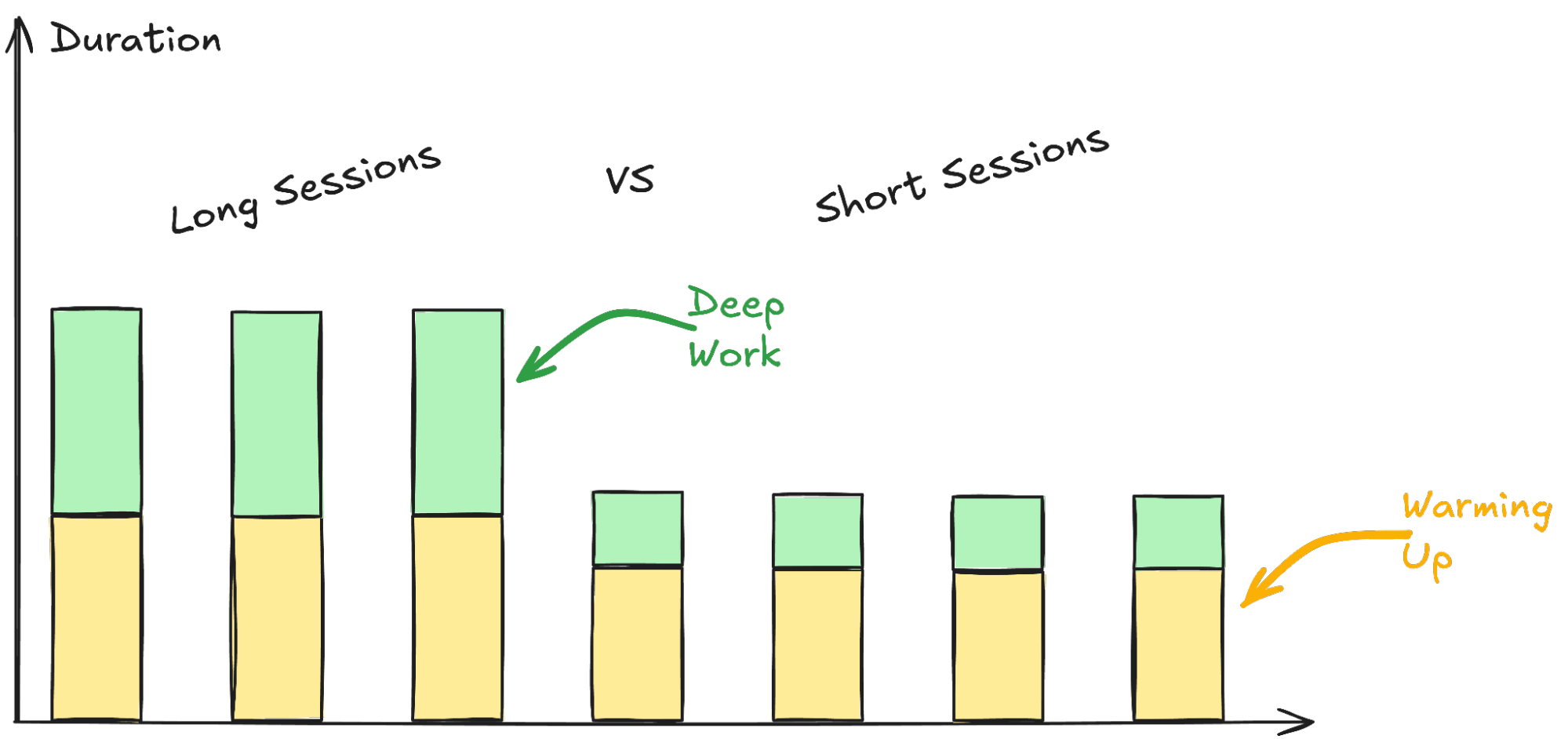One (and another) Gear in the Zettelkasten Machine: A Deep Dive into a Key Mechanism
This piece has two goals:
- Provide a tool to assess the benefits of various methods and tools for writing and thinking.
- A deeper dive into the iceberg of the Zettelkasten Method.
There are distinct but interconnected chains of cause and effect within each method.

The effects of low-intensity training (LIT) and deep thinking via the Zettelkasten method depend on their implementation, as method and outcome are inseparable.
Training: Low-intensity training (LIT) involves exercising at an intensity low enough to allow speaking in complete sentences, known as the talk test. You can implement LIT through infrequent long sessions or frequent shorter ones, each with distinct acute (short-term) and chronic (long-term) adaptations.
Longer, infrequent sessions provide a stronger stimulus per session, producing more signalling molecules (which trigger physiological adaptations) per minute, up to a certain threshold.
Shorter, more frequent sessions offer less endurance stimulus per session but minimize periods of inactivity, a negative stimulus. For example, daily morning LIT ensures every meal follows improved insulin sensitivity. Higher training frequency extends the time you benefit acutely from training, alongside fitness improvements.
Zettelkasten Method: Similarly, you can schedule deep thinking using the Zettelkasten method in longer, infrequent sessions or shorter, frequent ones.
Longer sessions improve the ratio of warming up to deep work.1
Shorter and more frequent sessions waste more time per session to warm you up.

Shorter downtime between sessions reduces warm-up time per session. This suits those frustrated by slow entry into deep focus. It also allows you to make deep thinking a part of your everyday life.
The good news is that frequent shorter sessions will train your brain to switch to thinking mode more often. Both habits and skills thrive on training volume. So, you might gain a benefit that you don’t gain with longer but infrequent sessions.
Rewriting is one of the many gears in the machine
Any method that encourages daily writing of ideas in your own words, such as Zettelkasten or a Commonplace Book, deepens your engagement with ideas.
If you work with your Zettelkasten frequently, you won’t benefit from adding a commonplace book to the mix. You are already getting the beneficial acute stimulus from writing notes in your Zettelkasten.
If you add the fact that Commonplace Books are inferior in terms of accessibility, especially when compared with a digital Zettelkasten, the reasons to have both dwindle. I, for example, write articles which add another layer of rewriting and changing the medium (from writing to think to writing to communicate). Yet another practice of rewriting wouldn’t benefit me that much anymore.
That doesn’t mean that a combination cannot be beneficial to somebody. A Commonplace Book, especially the handwritten ones, adds a lot of scholarly aesthetics to your work. Just take a look at the beautiful notebook collection of Leonardo da Vinci. After years of that practice, you’ll have a diary and a biography of your intellectual development, and a tool for nostalgia. I, thank you for asking, am not interested in any nostalgia in my life. I threw away all my diaries and notebooks. But you might have different inclinations.
To accurately understand the Zettelkasten Method and any method alike, you’ll have to develop a comprehensive inventory of all the cause-and-effect chains that lead to the various beneficial outcomes that you desire. The development of this inventory is part of the background work I perform to refine the method and my diagnostic toolset for coaching. I have to be able to make a decision which practice offers the best bang for the buck for the person.
The identification of chains of cause and effect is one of the cornerstones of the Zettelkasten Method: Each Step in the Process Must Be Knowledge-Based Value Creation. My goal is to create a set of principles, methods, and techniques that are optimised for value creation.
If you are serious about your knowledge work practice, you’ll have to take a deep look into the exact how of the benefits of each method. It is the same in training. You become considerably healthier by just playing soccer in a club and doing some calisthenics as part of your morning routine. But if you are serious about your performance or health, you’ll have to become enough of an expert to understand a structured training schedule and implement it.
Before you can put together a complete system, try to develop an inventory of knowledge work practices. Examples are:
- Deep thinking (frequency, duration)
- Reading (frequency, time of the day, duration)
- Writing
- Atomising ideas
- Application of creative techniques
- Idea connecting
- etc.
Another Gear: Atomising Ideas
Adhering to the principle of atomicity builds a habit of distilling ideas to their essence. One tool for atomising the ideas you think about is the inventory of knowledge building blocks.
Keep in mind that I didn’t write anything about “atomic notes”, but about the practice of atomising ideas. Theoretically, you could implement this practice without having a Zettelkasten.
From this one cause stem two effects:
- A deeper analytical understanding of the ideas you are working with.2
- Atomic notes, if you practice atomisation in written form.
The Zettelkasten Method shouldn’t add anything to your schedule. It instead restructures and reallocates the individual steps of your knowledge work. The same is true for the atomisation of ideas. It should be part of any knowledge work practice. It is that powerful.
If you have to write anyway, it is pragmatic to exploit this activity by creating a system of notes that can act as a competent communication partner.
—Luhmann
What’s the verdict, then? Deepen your knowledge work practice. Those who fail to develop a thinking environment like the Zettelkasten Method will be left behind.
Currently, there isn’t much pressure because it’s uncommon to think about our minds the way athletes think about their bodies. But watch what happens if somebody commits to his craft like Brandon Sanderson. The success of Sanderson stems from his systematic thinking and the implementation of methods and techniques across the entire value-creation chain in his writing. Right now, it is easy to stand out if you adopt this mindset. But in a future in which this is standard, adopting this mindset will be standard just to take part.
-
I am explicitly writing analytical understanding, because connecting ideas gives you a synthetic understanding. One is achieved by breaking the whole into parts; the other is achieved by bringing ideas together into a larger whole and identifying connections. ↩